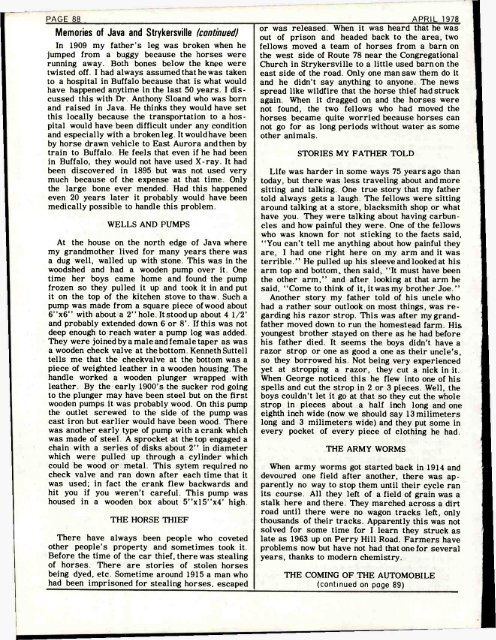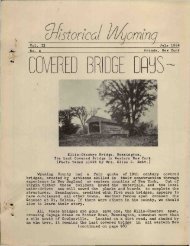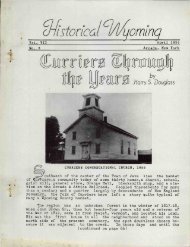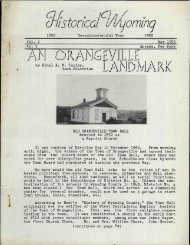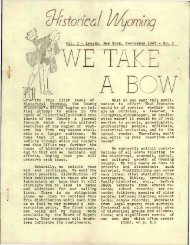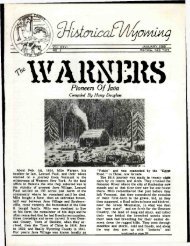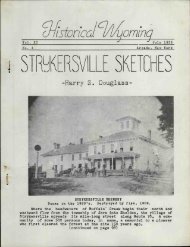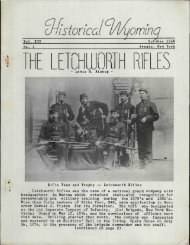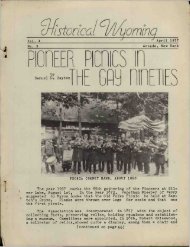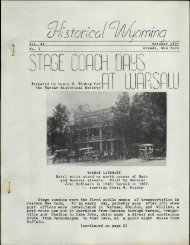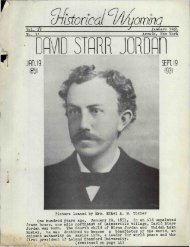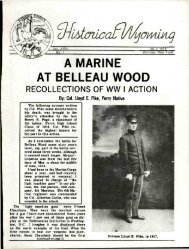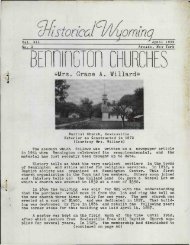By C. Kihm Richardson Walking from Strykersville ... - Fulton History
By C. Kihm Richardson Walking from Strykersville ... - Fulton History
By C. Kihm Richardson Walking from Strykersville ... - Fulton History
Create successful ePaper yourself
Turn your PDF publications into a flip-book with our unique Google optimized e-Paper software.
PAGE 88 APRIL 1978<br />
Memories of Java and <strong>Strykersville</strong> (continued)<br />
In 1909 my father's leg was broken when he<br />
jumped <strong>from</strong> a buggy because the horses were<br />
running away. Both bones below the knee were<br />
twisted off. I had always assumed that he was taken<br />
to a hospital in Buffalo because that is what would<br />
have happened anytime in the last 50 years. I discussed<br />
this with Dr. Anthony Sloand who was born<br />
and raised in Java. He thinks they would have set<br />
this locally because the transportation to a hospital<br />
would have been difficult under any condition<br />
and especially with a brokenleg. Itwouldhave been<br />
by horse drawn vehicle to East Aurora and then by<br />
train to Buffalo. He feels that even if he had been<br />
in Buffalo, they would not have used X-ray. It had<br />
been discovered in 1895 but was not used very<br />
much because of the expense at that time. Only<br />
the large bone ever mended. Had this happened<br />
even 20 years later it probably would have been<br />
medically possible to handle this problem.<br />
WELLS AND PUMPS<br />
At the house on the north edge of Java where<br />
my grandmother lived for many years there was<br />
a dug well, walled up with stone. This was in the<br />
woodshed and had a wooden pump over it. One<br />
time her boys came home and found the pump<br />
frozen so they pulled it up and took it in and put<br />
it on the top of the kitchen stove to thaw. Such a<br />
pump was made <strong>from</strong> a square piece of wood about<br />
6"x6" with about a 2" hole. Itstoodup about 4 1/2'<br />
and probably extended down 6 or 8'. If this was not<br />
deep enough to reach water a pump log was added.<br />
They were joined by a male and female taper as was<br />
a wooden check valve at the bottom. Kenneth Suttell<br />
tells me that the checkvalve at the bottom was a<br />
piece of weighted leather in a wooden housing. The<br />
handle worked a wooden plunger wrapped with<br />
leather. <strong>By</strong> the early 1900's the sucker rod going<br />
to the plunger may have been steel but on the first<br />
wooden pumps it was probably wood. On this pump<br />
the outlet screwed to the side of the pump was<br />
cast iron but earlier would have been wood. There<br />
was another early type of pump with a crank which<br />
was made of steel. A sprocket at the top engaged a<br />
chain with a series of disks about 2" in diameter<br />
which were pulled up through a cylinder which<br />
could be wood or metal. This sytem required no<br />
check valve and ran down after each time that it<br />
was used; in fact the crank flew backwards and<br />
hit you if you weren't careful. This pump was<br />
housed in a wooden box about 5"xl5"x4' high.<br />
THE HORSE THIEF<br />
There have always been people who coveted<br />
other people's property and sometimes took it.<br />
Before the time of the car thief, there was stealing<br />
of horses. There are stories of stolen horses<br />
being dyed, etc. Sometime around 1915 a man who<br />
had been imprisoned for stealing horses, escaped<br />
or was released. When it was heard that he was<br />
out of prison and headed back to the area, two<br />
fellows moved a team of horses <strong>from</strong> a barn on<br />
the west side of Route 78 near the Congregational<br />
Church in <strong>Strykersville</strong> to a little used barn on the<br />
east side of the road. Only one man saw them do it<br />
and he didn't say anything to anyone. The news<br />
spread like wildfire that the horse thief had struck<br />
again. When it dragged on and the horses were<br />
not found, the two fellows who had moved the<br />
horses became quite worried because horses can<br />
not go for as long periods without water as some<br />
other animals.<br />
STORIES MY FATHER TOLD<br />
Life was harder in some ways 75 years ago than<br />
today, but there was less traveling about and more<br />
sitting and talking. One true story that my father<br />
told always gets a laugh. The fellows were sitting<br />
around talking at a store, blacksmith shop or what<br />
have you. They were talking about having carbuncles<br />
and how painful they were. One of the fellows<br />
who was known for not sticking to the facts said,<br />
"You can't tell me anything about how painful they<br />
are, I had one right here on my arm and it was<br />
terrible." He pulled up his sleeve and looked at his<br />
arm top and bottom^ then said, "It must have been<br />
the other arm," and after looking at that arm he<br />
said, "Come to think of it, it was my brother Joe."<br />
Another story my father told of his uncle who<br />
had a rather sour outlook on most things, was regarding<br />
his razor strop. This was after my grandfather<br />
moved down to run the homestead farm. His<br />
youngest brother stayed on there as he had before<br />
his father died. It seems the boys didn't have a<br />
razor strop or one as good a one as their uncle's,<br />
so they borrowed his. Not being very experienced<br />
yet at stropping a razor, they cut a nick in it.<br />
When George noticed this he flew into one of his<br />
spells and cut the strop in 2 or 3 pieces. Well, the<br />
boys couldn't let it go at that so they cut the whole<br />
strop in pieces about a half inch long and one<br />
eighth inch wide (now we should say 13milimeters<br />
long and 3 milimeters wide) and they put some in<br />
every pocket of every piece of clothing he had.<br />
THE ARMY WORMS<br />
When army worms got started back in 1914 and<br />
devoured one field after another, there was apparently<br />
no way to stop them until their cycle ran<br />
its course. All they left of a field of grain was a<br />
stalk here and there. They marched across a dirt<br />
road until there were no wagon tracks left, only<br />
thousands of their tracks. Apparently this was not<br />
solved for some time for I learn they struck as<br />
late as 1963 up on Perry Hill Road. Farmers have<br />
problems now but have not had that one for several<br />
years, thanks to modern chemistry.<br />
THE COMING OF THE AUTOMOBILE<br />
(continued on page 89)


